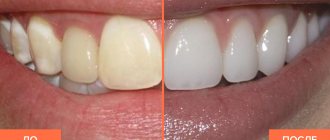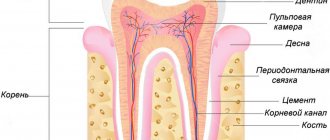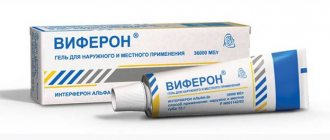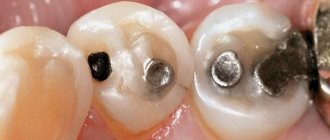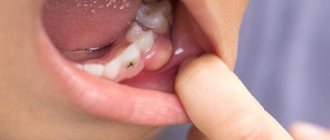Classification of fluorosis
The disease is divided into degrees of severity:
- The first is doubtful fluorosis. These are barely noticeable white spots on the enamel that become better visible when the surface dries.
- The second is very weak. Opaque white spots occupy up to 25% of the enamel surface.
- The third is weak. The lesion covers from 25 to 50%.
- The fourth is moderate. The surface of the tooth is completely damaged, abrasion and brown spots are noticeable on the enamel, and the relief is modified.
- Fifth – heavy defeat. There are significant brown areas and serious enamel destruction.
Treatment
Very mild and mild forms of fluorosis do not require mandatory treatment. If you do teeth whitening with subsequent remineralization of the enamel, the prognosis for improving appearance with this, the most gentle type of intervention, is very favorable. Immediately, on the day of bleaching, the spots may become more noticeable, but then their brightness decreases and approaches the color of healthy enamel. If the achieved result is imperfect, the whitening procedure can be repeated 2-3 times. Remineralization of enamel should be carried out after etching with acid - this will dissolve fluorapatite crystals and subsequently replace them with hydroxyapatite. For moderate cases, it is also best to start with the least invasive option - teeth whitening. The probability of removing stains in this case is also quite high. If the whitening effect is insufficient, you can try microabrasion of the enamel - gentle superficial grinding of the affected areas, also after preliminary etching. If bleaching and microabrasion fail, restoration with fillings or veneers can be considered. It is worth noting that some patients consider the conversion of yellow-brown spots to matte white to be a worthy result and refuse further restoration treatment. In severe cases, bleaching is ineffective. In case of minor enamel damage and no patient complaints, observation is recommended. There is no need to chase every small defect with a bur, drilling out as much more healthy enamel along the way (especially outside the visible smile zone). If the damage has already formed cavities where food debris accumulates, then the need for restoration treatment arises. Filling, inlay, onlay, veneer or crown - the type of restoration is determined by the area and volume of the lesion.
Forms
The streak form is characterized by barely noticeable stripes in the subsurface enamel layer. They are hardly noticeable and form on the vestibular surface of the incisors.
In the spotted form, chalky spots alternate with areas of healthy enamel. The incisors are most often affected. Sometimes the formation takes on a yellowish-brown tint. But the enamel always remains smooth and dense, with an intact structure.
The chalky mottled form has various symptoms. Distinct pigmented spots are visible on the enamel. The enamel may be yellow, with spots and dots, and other minor defects. It quickly wears away, exposing pigmented dark brown dentin.
The erosive form is accompanied by unaesthetic erosions on which there is no enamel. Destructive is characterized by a violation of the shape of the crowns of the teeth due to abrasion of hard tissues. They become brittle and break off easily, but due to the formation of replacement dentin, the tooth cavity is not opened.
Etiology and forms
Fluorine is an essential element of mineral metabolism, participates in hematopoiesis, the formation of bone tissue and teeth, prevents the development of caries, and also ensures the removal of heavy metal salts from the body. The chemical compound enters through the respiratory tract, skin and digestive tract. Fluoride accumulates in the body and accumulates in teeth, connective and bone structures.
The disease is occupational or endemic in nature, that is, it is characteristic of a certain geographical area. There are also five main forms of mild, moderate and severe:
- spotted;
- dashed;
- chalky-speckled;
- erosive;
- destructive.
Fluorosis affecting the first set of teeth in children is rare and in most cases goes away on its own when temporary units are replaced with molars. Pathological changes, as a rule, occur during the eruption of permanent teeth in children living in areas with increased concentrations of the chemical element in water. With a pronounced degree of fluorosis, the risks of carious processes are high.
Subtleties of differential diagnosis of fluorosis
It is very important to distinguish fluorosis from enamel hypoplasia, especially from its patchy form. Chalky spots in both diseases are located symmetrically, in areas of the crown that are not typical for caries. As a rule, these are the labial and lingual surfaces, cusps and cutting edge. With fluorosis, they have a pearly white tint, are shiny, do not cause pain during probing, and gradually turn into healthy enamel.
With hypoplasia, the spots are white and dense, also shiny, but with clear boundaries. Under the influence of UV rays, with fluorosis, chalky spots give a light blue glow (pigmented ones - red-brown), with hypoplasia - light yellow. Fluorosis is not prone to changes in spots, while formations with hypoplasia often require treatment for caries in children, since they change and progress.
Symptoms
Dental fluorosis is characterized by the appearance of pale spots or numerous stripes on the enamel. As the disease progresses, the defects acquire a yellow, brownish tint. Defects most often affect the maxillary incisors; against the background of excessive concentrations of fluoride compounds, the disease covers all teeth. Increased abrasion of the enamel develops, chips and erosive areas appear on it. Symptomatic manifestations depend on the type of pathology:
- Styriform fluorosis
small stripes
(strokes) appear on the enamel - Spotted
- this form is characterized by the appearance of numerous whitish (chalky) spots joining together. The spots have a smooth, glossy surface (similar to caries in the spot stage). Unlike a carious defect, they do not have clear boundaries, but smoothly merge with healthy areas of enamel. - Chalky-mottled
- pigment spots are formed with clear boundaries, multiple dots are visible. The enamel layer turns yellow, quickly thins, dentin is exposed, and the tooth becomes very sensitive to mechanical, chemical, and thermal irritants. - Erosive fluorosis
- volumetric defects appear - erosion. Tooth enamel in these areas is completely absent, dentin tissue is exposed. - Destructive
- a severe degree in which not only enamel, but also dentin is destroyed. The tooth is fragile, susceptible to chips and fractures, the crown part is deformed, the defects are very noticeable.
The destructive type is found in areas where the level of fluoride compounds in water is 10 mg/l or higher. Pathology can cover several dental units or the entire row.
Treatment of fluorosis
The treatment regimen depends on the severity of the disease, general health and the influence of endemic factors. Therapy solves the following problems:
- reduce excessive intake of fluoride into children’s bodies from drinking water and food products;
- weaken the toxic effect of increased concentrations of fluoride on the body (the child is prescribed calcium preparations that bind fluoride and remove it).
Topical treatment for fluorosis depends on the severity. For any clinical picture, it is recommended to brush your teeth twice with toothpastes that contain calcium glycerophosphate, for example “Pearls” or “Calcium Complex”. At the first stage, no further action is required.
In the presence of pigmented spots, whitening is sometimes carried out followed by remineralization - only after 16 years under the supervision of a dentist. There are other methods of combating age spots, for example, removing pigmented enamel using microabrasion.
In erosive and destructive forms, when there is loss of hard tissue, the anatomical shape of the tooth can be restored with composite materials. Orthopedic treatment is sometimes indicated.
Classification
Based on anthropogenesis, fluorosis is divided into endemic and occupational. Although the clinical manifestations of both types of disease are similar, the treatment approach is different. In the professional form of the disease, not only tooth enamel is affected, but also bone tissue, and osteosclerosis and osteoporosis develop. As the disease progresses, disorders of the vascular system and liver occur, and the risk of developing osteosarcoma increases many times over. In this case, fluorescent spots on the enamel layer are often absent.
Forms of fluorosis:
- spotted;
- dashed;
- erosive;
- chalky mottled;
- destructive.
Spotted and streaked fluorosis is a mild type of pathology, erosive and destructive are classified as severe. A patient can be diagnosed simultaneously with different forms of the disease - different clinical pictures are observed on individual dental units and groups of teeth.
Prevention of fluorosis
Prevention of fluorosis should be carried out in geographic areas where the fluoride content in drinking water exceeds 2 mg/l. Ideally, it is desirable to solve this problem collectively - to eliminate the etiological factor. If this is not possible, drinking water is defluoridated using a reagent or filtration method. Such water is also mixed with water from artesian wells or mountain rivers to reduce the concentration of fluoride. You can also remove fluoride from water at home by freezing, boiling and settling, and filtering through a layer of magnesium oxide.
Individual prevention involves the use of imported clean water for cooking. It is very important to limit the consumption of foods high in fluoride - strong tea, sea fish, seafood. In the winter-spring period, children from 2-3 years of age at risk are prescribed calcium supplements for a month, as well as ascorbic acid.
Dental fluorosis
Fluorosis, or chalky speckled enamel, is a disease that occurs due to prolonged intake of a large dose of fluoride into the body. The content of this microelement in bones is affected by the composition of drinking water. Fluoride is also found in food and even in toothpastes, but from there it is absorbed much worse than fluorides found in water. Therefore, fluorosis is endemic, that is, it is a disease characteristic of a certain area where the water is oversaturated with fluoride. There is also occupational fluorosis - it occurs in workers of enterprises where the content of fluoride compounds in the air is exceeded. However, this type of disease is not very common among the population.
The most susceptible to endemic fluorosis are children and adolescents whose permanent teeth have not yet erupted or whose enamel has not yet strengthened. The daily need for fluoride at this age is 2–3 mg, which the child receives from food and water. For the development of the disease, the maximum permissible concentration of fluoride in water – 1.5 mg/l – will be sufficient. Adults with already formed tooth enamel, even with prolonged use of such water, will not get fluorosis, since the daily norm is already 4 mg. However, if the fluoride content exceeds 6 mg/l, then the teeth of the adult population are also affected. You can find out about the fluoride content in the water in your region by calling the nearest branch of the Sanitary and Epidemiological Station.
Attention!
A fluoride concentration in water of less than 1.5 mg/l also leaves 10–30% of the population at risk of developing fluorosis.
Stages of fluorosis
There are 3 stages of disease development:
- The first is that white spots and streaks appear on the teeth. Often at this stage of the disease, manifestations are invisible and can only be identified by a doctor. This is another reason why you need to visit the dentist regularly - every 6 months.
- The second is that pigment spots and stripes acquire a yellow color. Pigmentation intensifies over time and dark spots appear.
- The third is damage to a significant part of the enamel. It becomes soft, causing the crown part of the tooth to become deformed.
Prevention measures
- Maximum duration of breastfeeding for infants in areas with unfavorable endemic conditions
- Drinking water with normal fluoride content (bottled or purified with a special filter)
- Balanced diet. At the same time, we do not forget that this element is still necessary for the formation of bones and the prevention of the development of caries
- Additional intake of calcium and phosphorus supplements (they promote the removal of fluoride)
- Using fluoride-free toothpastes and rinses
The dental network offers diagnostic services and effective treatment of dental fluorosis of any form. Contacting our specialists has the following advantages:
- treatment by highly qualified doctors;
- compliance with international standard treatment protocols;
- family and savings discounts;
- transparent pricing;
- daily work schedule until 21:00 (on Sunday until 16:00).
You can make an appointment at any of the branches of our clinic in Moscow, located within walking distance from metro stations:
- Art. Alekseevskaya (VDNKh district, etc. Mira), address: st. 3rd Mytishchiskaya house 3, building 2;
- Art. Shelepikha, address: Shelepikhinskaya embankment, address: building 34, building 1.
Modern equipment and a high level of specialist training allow us to provide comprehensive medical services. We are ready to help patients with any clinical case and offer solutions to the problem. Your health is in good hands!
Signs and symptoms of dental fluorosis
The disease can be of two types - endemic or occupational. Symptoms of endemic dental fluorosis are represented by damage to molars. Depending on the complexity of the disease, brown or white spots and erosions appear on the teeth, with increased abrasion and fragility of the enamel.
Signs of professional dental fluorosis are usually represented by decreased joint mobility, with pain in the joints and bones. Often, in severe forms of the disease, disturbances in the functioning of the autonomic nervous system, muscle weakness, and problems with the liver occur.
Degrees of development
This disease develops slowly because it is quite complex and serious. According to doctors, it is worth highlighting the following stages of fluorosis development:
- 1st degree. Here small spots appear on the tooth enamel and its surface. But some teeth suffer, not all;
- 2nd degree. It is worth noting the chalky spots here, but pigmented spots also appear that are pronounced. They have a yellow, brown tint;
- 3rd degree. Most of the enamel is affected, and the crown may become deformed. In addition, enamel is soft and can be worn out. In this case, the tooth remains without its protection.
